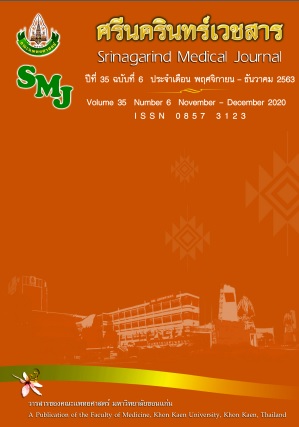Accuracy of Multi-parametric Magnetic Resonance Imaging for Diagnosis of Prostate Cancer
Abstract
ความแม่นยำของการตรวจวินิจฉัยมะเร็งต่อมลูกหมากด้วยเครื่องตรวจคลื่นสนามแม่เหล็กไฟฟ้าด้วยวิธีการหลายพารามิเตอร์
ชลิดา อภินิเวศ*, ชยานนท์ ชินพรเจริญพงษ์, กุลญาดา สมทรัพย์, วัลลภ เหล่าไพบูลย์
ภาควิชารังสีวิทยา คณะแพทยศาสตร์ มหาวิทยาลัยขอนแก่น จังหวัดขอนแก่น
Objective: To assess the diagnostic accuracy of magnetic resonance imaging (MRI) for prostate cancer with multiple parameters.
Methods: Patients who underwent both MRI and transrectal ultrasound-guided biopsy from July 2012 to August 2014, were reviewed retrospectively. Multiple parameters were assessed to determine the accuracy of MRI for prostate cancer; the apparent diffusion coefficient (ADC), dynamic contrast enhanced MRI (DCE-MRI), and the Cho/cit and (Cho+creat)/cit ratios. The areas under the receiver operating characteristic curves (AUC) were used to evaluate the diagnostic accuracy of metabolic ratios.
Results: Thirty-six lesions from 28 patients were analyzed. Malignant lesions at the peripheral zone showed significantly lower ADCs than benign lesions (p < 0.01). If lesion size was 1 cm or larger, the (Cho+creat)/cit ratio was significantly higher (p < 0.01). The ADCs had a high specificity of 87.5%, an accuracy of 77.8%, and AUC of 0.68. DCE-MRI had high specificity of 91.7%, accuracy of 83.3%, and an AUC 0.78. The Cho/cit ratios showed a high sensitivity of 91.7%, but low specificity of 54.2%. The greatest AUC was 0.85 when the DCE-MRI was combined with the Cho/cit ratio, giving an accuracy of 83.3%. No significant improvement was established, however, when all 3 parameters were combined together.
Conclusion: DCE-MRI and ADC had greater diagnostic accuracy than MR spectroscopy (MRS). Combined parameters improved specificity for prostate cancer lesions.
Keywords: Diagnostic accuracy; Magnetic resonance imaging; Prostate cancer; Sensitivity; Specificity; Apparent diffusion coefficient, dynamic contrast enhanced MRI; Cho/cit ratio, (Cho+creat)/cit ratio .
วัตถุประสงค์: เพื่อศึกษาความแม่นยำของการตรวจวินิจฉัยมะเร็งต่อมลูกหมากด้วยเครื่องตรวจคลื่นสนามแม่เหล็กไฟฟ้าด้วยวิธีการหลายพารามิเตอร์
วิธีการศึกษา: เป็นการศึกษาย้อนหลังในผู้ป่วยที่ได้รับการตรวจด้วยเครื่องตรวจคลื่นสนามแม่เหล็กไฟฟ้า ร่วมกับการเจาะตรวจชิ้นเนื้อทางพยาธิวิทยาผ่านเครื่องตรวจคลื่นเสียงทางทวารหนัก ระหว่างเดือน กรกฎาคม 2555 ถึง สิงหาคม 2557 ภาพการตรวจด้วยคลื่นสนามแม่เหล็กไฟฟ้าประกอบด้วยหลายพารามิเตอร์ ได้แก่ ADC, DCE-MRI, Cho/cit ratio และ (Cho+creat)/cit ratio แล้วประเมินความแม่นยำในการตรวจวินิจฉัยโดยอาศัย AUC
ผลการศึกษา: การศึกษานี้ครอบคลุม 36 รอยโรคจากผู้ป่วย 28 ราย รอยโรคที่เป็นมะเร็งใน peripheral zone ให้ค่า ADC ต่ำกว่ารอยโรคที่ไม่ใช่มะเร็งอย่างมีนัยสำคัญ (p < 0.01) หากรอยโรคนั้นมีขนาดตั้งแต่ 1 ซม. ขึ้นไป จะให้ค่า (Cho+creat)/cit ratio สูงกว่าอEย่างมีนัยสำคัญ พารามิเตอร์ ADC มีความจำเพาะสูงถึงร้อยละ 87.5 ความแม่นยำร้อยละ 77.8 และ AUC 0.68 เช่นเดียวกันกับ พารามิเตอร์ DCE-MRI มีความจำเพาะสูงถึงร้อยละ 91.7 ความแม่นยำร้อยละ 83.3 และ AUC 0.78 พารามิเตอร์ Cho/cit ratio มีความจำเพาะสูงถึง ร้อยละ 91.7 แต่ความแม่นยำต่ำเพียงร้อยละ 54.2 เมื่อนำพารามิเตอร์ DCE-MRI มาร่วมกับ Cho/cit ratio จะให้ค่า AUC สูงที่สุดที่ 0.85 และมีความแม่นยำถึงร้อยละ 83.3 อย่างไรก็ตามการนำพารามิเตอร์ทั้งสามมาใช้ร่วมกัน กลับไม่ได้เพิ่มประสิทธิภาพอย่างมีนัยสำคัญ
สรุป: การตรวจด้วย DCE-MRI ร่วมกับ ADC มีความแม่นยำในการตรวจวินิจฉัยมะเร็งต่อมลูกหมาก สูงกว่าการตรวจด้วย MRS
คำสำคัญ : มะเร็งต่อมลูกหมาก; การตรวจด้วยเครื่องสะท้อนสนามแม่เหล็ก; ความแม่นยำในการวินิจฉัย


